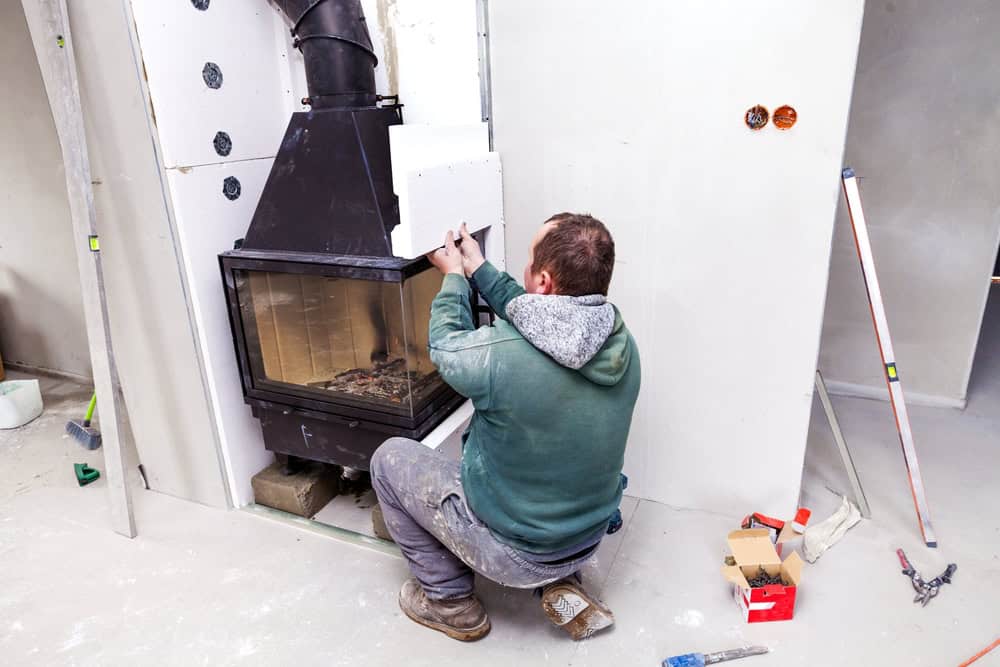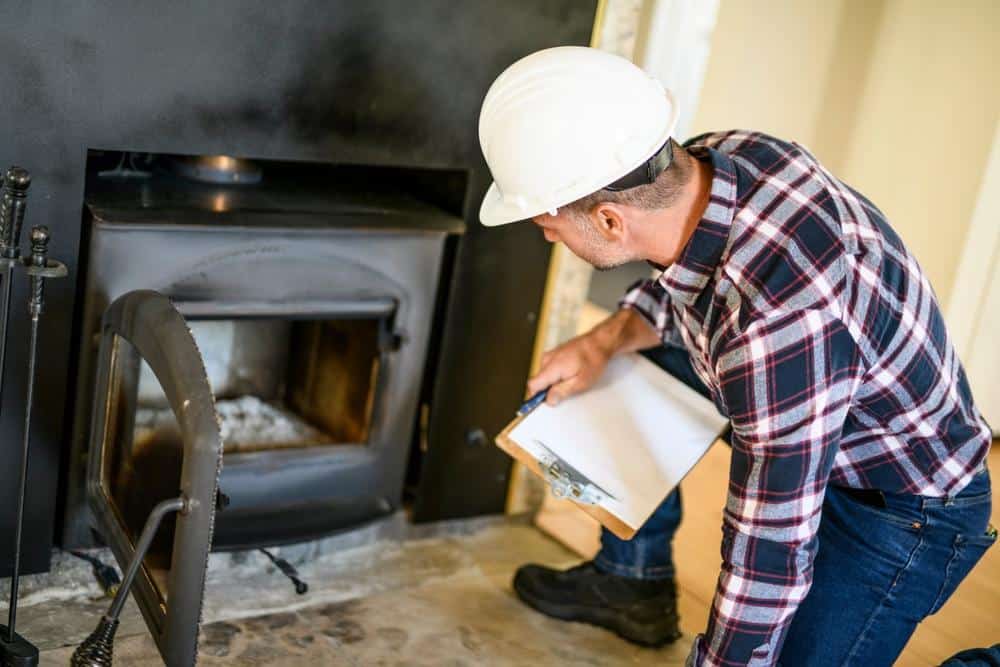
Summary:
Historic homes across Rhode Island face a perfect storm of conditions that accelerate chimney deterioration. The state’s coastal location brings salt air that corrodes metal components and penetrates masonry. Winter temperatures create freeze-thaw cycles that expand cracks in mortar and clay tiles.
Many homes built before 1920 lack proper flue liners entirely. Those that do have liners often feature clay tiles that were adequate for their time but struggle with today’s heating demands. These original systems weren’t designed for modern high-efficiency appliances or the temperature fluctuations they create.
The result is a ticking clock. Without proper intervention, deteriorating flue systems become safety hazards that threaten both your family and your historic investment.

Clay tile liners were the standard for decades, but Rhode Island’s climate is particularly hard on these systems. The freeze-thaw cycle is the primary culprit – water seeps into hairline cracks, freezes overnight, and expands to create larger openings.
This process accelerates dramatically in coastal areas where salt air increases moisture penetration. Providence County homes, especially those near Narragansett Bay, see faster deterioration than inland properties. The salt doesn’t just affect metal components – it changes how moisture interacts with clay and mortar.
You’ll notice the damage as white staining (efflorescence) on your chimney’s exterior. This indicates water is getting where it shouldn’t, carrying dissolved salts to the surface as it evaporates. Inside, cracked clay tiles allow dangerous gases to escape into your chimney walls instead of venting safely outside.
Historic homes in Federal Hill, East Side Providence, and other established neighborhoods often show these patterns. The original clay liners served well for decades, but they weren’t built to handle modern heating appliances or today’s climate stresses.
Winter heating cycles compound the problem. Your heating system creates temperature swings that stress already weakened clay tiles. A liner that looks intact during summer inspections might fail completely during the first cold snap.
The danger isn’t just structural. Cracked clay liners can leak carbon monoxide into your living spaces. They also allow heat to transfer to combustible materials in your walls – a serious fire risk that insurance companies and building codes no longer accept.
Moisture damage in historic Rhode Island chimneys extends far beyond cracked flue tiles. The masonry itself becomes a pathway for water intrusion, especially in homes where original lime-based mortars have deteriorated over time.
Historic chimneys were built with different materials and techniques than modern construction. Lime mortars were designed to be flexible, allowing the structure to move with temperature changes. But after a century or more, these mortars break down and become porous pathways for moisture.
Rhode Island’s coastal humidity makes the problem worse. Unlike inland areas where moisture comes primarily from rain and snow, coastal properties deal with constant humidity that penetrates masonry from all directions. This creates conditions where traditional waterproofing approaches often fail.
The brick itself becomes part of the problem. Historic bricks were fired differently than modern ones, often making them more porous. When these bricks absorb moisture, freeze-thaw cycles cause spalling – the surface layer flakes off, exposing more porous material underneath.
Crown damage is another common issue. The concrete or mortar cap at the top of your chimney cracks from temperature changes, allowing water to pour directly into the chimney structure. In historic homes, these crowns were often built with materials that don’t match the expansion rates of the original masonry.
Flashing failures compound moisture problems. The metal strips that seal where your chimney meets the roof corrode faster in salt air. Even small gaps let significant water into your home during storms. Many historic homes have galvanized flashing that’s reached the end of its useful life.
The cumulative effect creates a cycle where moisture damage accelerates over time. Small cracks become larger openings. Surface damage penetrates deeper into the structure. What starts as minor maintenance becomes major restoration work if left unaddressed.
Want live answers?
Connect with a Certified Chimney Inspections expert for fast, friendly support.
Choosing the right relining approach for your historic Rhode Island home requires balancing preservation goals with safety requirements. Modern building codes demand proper flue liners, but the installation method can either preserve or compromise your home’s architectural integrity.
The three primary options each serve different situations. Stainless steel liners offer durability and versatility. Cast-in-place systems provide superior performance for complex installations. Traditional clay tile replacement maintains historic authenticity where feasible.
Your choice depends on your chimney’s condition, your heating system requirements, and your preservation priorities. Let’s examine when each approach makes sense.

Stainless steel liners have become the standard for most Rhode Island chimney relining projects, and for good reason. They resist corrosion from salt air better than aluminum alternatives and handle the acidic byproducts from modern heating systems that destroy clay tiles.
The installation process is relatively straightforward and can usually be completed in a single day. We lower the flexible stainless steel liner down your existing flue from the top, connecting it properly to your heating appliance and sealing it at the crown. This approach leaves your exterior masonry completely untouched.
For historic homes, this preservation of original stonework is crucial. You maintain the authentic appearance while gaining modern safety performance. The liner is hidden inside your chimney, invisible from both interior and exterior viewpoints.
Stainless steel liners typically last 15-20 years in Rhode Island’s coastal climate, significantly longer than repaired clay systems. They’re suitable for wood, gas, or oil heating systems and can be sized precisely for your appliance’s requirements.
The main limitation is sizing. Historic chimneys often have unusual flue dimensions that don’t match standard liner sizes. Some colonial chimneys feature long, narrow flues that served multiple fireplaces. These may require custom fabrication or alternative approaches.
Cost is reasonable compared to other options. Most installations range from $1,500 to $4,000 depending on your chimney’s height and complexity. The investment provides immediate safety improvements and long-term protection against further deterioration.
Maintenance requirements are minimal. Annual inspections and regular cleaning remove corrosive creosote buildup that can shorten liner life. Proper maintenance helps these systems reach or exceed their expected lifespan.
Cast-in-place liners represent the premium solution for historic chimney relining, especially when dealing with structural damage or unusual flue configurations. This system creates a seamless, custom-fitted liner that’s poured or sprayed in place within your existing chimney.
The process involves removing damaged clay tiles and creating a smooth, permanent flue surface using specialized ceramic materials. The result is a liner that matches your chimney’s exact dimensions while providing superior heat resistance and structural integrity.
For Rhode Island’s historic homes, cast-in-place systems offer unique advantages. They can accommodate the irregular flue shapes common in colonial construction. Stone-ender chimneys and other historic designs often have flues that taper, bend, or change dimensions – situations where standard stainless steel liners won’t work.
The thermal properties are exceptional. Cast-in-place liners can handle temperatures exceeding 2,100°F and resist the freeze-thaw cycles that destroy other materials. They’re particularly effective in chimneys with existing structural damage, essentially rebuilding the flue system from the inside out.
Installation takes longer than stainless steel systems, typically requiring an overnight curing period. The process is more complex and requires specialized equipment and expertise. Not all chimney companies offer this service, making it important to work with experienced professionals.
The cost reflects the premium performance. Cast-in-place systems typically cost four times more than stainless steel alternatives, but they provide superior longevity and performance. For historic homes where preservation and long-term protection are priorities, the investment often makes sense.
Maintenance requirements are minimal once installed. The seamless surface resists creosote buildup better than jointed systems. Regular inspections and cleaning are still important, but the liner itself requires little ongoing attention.
For Rhode Island homeowners dealing with severely damaged flue systems or complex historic chimney configurations, cast-in-place liners often provide the only viable long-term solution that maintains both safety and architectural integrity.
Your historic Rhode Island home deserves solutions that honor its past while securing its future. Proper chimney relining isn’t just about meeting building codes – it’s about preserving a piece of New England’s architectural heritage for generations to come.
The key is working with professionals who understand both historic construction methods and modern safety requirements. Whether you choose stainless steel for practical protection or cast-in-place for premium performance, the right installation preserves your home’s character while eliminating safety risks.
Don’t wait for small problems to become major restoration projects. Rhode Island’s freeze-thaw cycles and coastal moisture accelerate damage once it starts. Contact us to discuss the best relining approach for your historic home’s unique needs.